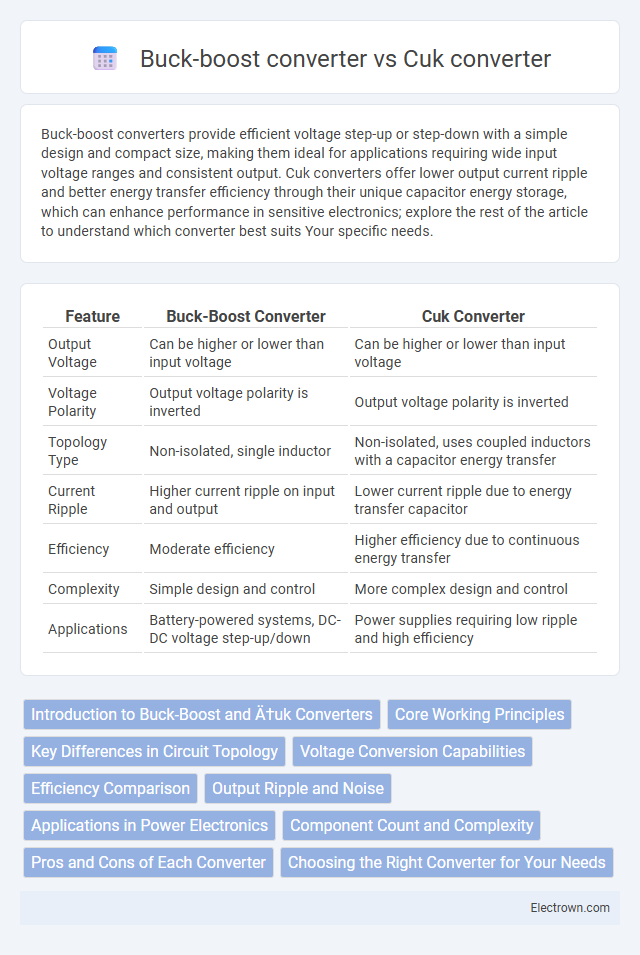Buck-boost converters provide efficient voltage step-up or step-down with a simple design and compact size, making them ideal for applications requiring wide input voltage ranges and consistent output. Cuk converters offer lower output current ripple and better energy transfer efficiency through their unique capacitor energy storage, which can enhance performance in sensitive electronics; explore the rest of the article to understand which converter best suits Your specific needs.
Table of Comparison
| Feature | Buck-Boost Converter | Cuk Converter |
|---|---|---|
| Output Voltage | Can be higher or lower than input voltage | Can be higher or lower than input voltage |
| Voltage Polarity | Output voltage polarity is inverted | Output voltage polarity is inverted |
| Topology Type | Non-isolated, single inductor | Non-isolated, uses coupled inductors with a capacitor energy transfer |
| Current Ripple | Higher current ripple on input and output | Lower current ripple due to energy transfer capacitor |
| Efficiency | Moderate efficiency | Higher efficiency due to continuous energy transfer |
| Complexity | Simple design and control | More complex design and control |
| Applications | Battery-powered systems, DC-DC voltage step-up/down | Power supplies requiring low ripple and high efficiency |
Introduction to Buck-Boost and Ćuk Converters
Buck-boost converters efficiently step voltage levels up or down by inverting the polarity of the output relative to the input, ideal for applications requiring voltage flexibility from a single power source. Cuk converters utilize a capacitor and inductor combination to provide a smooth, continuous current output with inverted voltage polarity, optimizing energy transfer with low ripple. Your choice depends on whether you need simple voltage inversion with energy efficiency (buck-boost) or low noise with improved current quality (Cuk).
Core Working Principles
The Buck-boost converter operates by switching an inductor between input and output, storing energy during the ON phase and releasing it in the OFF phase to provide output voltage either higher or lower than the input. The Cuk converter uses a capacitor as the main energy transfer element, along with inductors on both input and output sides, enabling continuous current flow and voltage inversion with reduced ripple. Both converters rely on PWM control and energy storage components but differ in energy transfer methods and output characteristics.
Key Differences in Circuit Topology
The Buck-boost converter uses a single inductor and switch to provide an output voltage that can be higher or lower than the input voltage with a polarity inversion. The Cuk converter employs two inductors, a capacitor for energy transfer, and both switch and diode, enabling continuous input and output currents with inverted polarity. Unlike the Buck-boost, the Cuk converter offers lower ripple in input and output currents due to its unique energy transfer through a capacitor rather than an inductor alone.
Voltage Conversion Capabilities
Buck-boost converters efficiently provide output voltages either higher or lower than the input voltage with a simpler design and fewer components. Cuk converters offer continuous input and output currents with voltage inversion, enabling smooth step-up or step-down voltage conversion while minimizing ripple. Both converters serve versatile voltage conversion needs, but the Cuk converter excels in applications requiring low noise and precise voltage inversion.
Efficiency Comparison
Buck-boost converters generally achieve higher efficiency in applications requiring simple voltage step-up or step-down due to fewer components and lower switching losses. The Cuk converter, while offering continuous input and output currents with lower ripple, tends to have slightly reduced efficiency because of additional energy transfer elements like the capacitor and inductors. Your choice between these converters should balance efficiency needs with output current quality and complexity constraints.
Output Ripple and Noise
Buck-boost converters typically exhibit higher output ripple and noise due to their switching topology, which can cause more pronounced voltage spikes and electromagnetic interference. Cuk converters use capacitive energy transfer to produce a smoother, lower ripple output voltage with reduced noise, enhancing the quality of power for sensitive applications. Understanding these differences can help you select the converter best suited for minimizing output disturbances in your system.
Applications in Power Electronics
Buck-boost converters are widely used in battery-powered devices and DC motor control systems where voltage regulation above or below the input voltage is critical. Cuk converters find applications in renewable energy systems and audio amplifiers due to their ability to provide continuous input and output currents with low ripple. Both converters optimize power conversion efficiency and are integral to voltage regulation in modern power electronics.
Component Count and Complexity
Buck-boost converters typically feature a lower component count and simpler design, utilizing mainly an inductor, switch, diode, and capacitor, which results in easier implementation and reduced cost. Cuk converters require additional components, including two inductors, a capacitor for energy transfer, a switch, and a diode, increasing circuit complexity and size. This higher component count in Cuk converters offers benefits such as smoother current waveforms and reduced input/output ripple but requires more intricate control strategies and layout considerations.
Pros and Cons of Each Converter
The Buck-boost converter offers a simple design with a wide input voltage range and the ability to step voltage up or down efficiently but suffers from higher ripple current and lower efficiency at certain load conditions. The Cuk converter provides continuous input and output currents with reduced voltage ripple and better efficiency but involves a more complex design, increased component count, and potential stability challenges. Choosing between them depends on specific application requirements such as efficiency, complexity, and acceptable ripple levels.
Choosing the Right Converter for Your Needs
Buck-boost converters excel in applications requiring a simple topology with efficient step-up or step-down voltage conversion, making them ideal for battery-powered devices and power management systems. Cuk converters provide continuous input and output currents with low ripple, suitable for sensitive electronics requiring stable power supply and lower electromagnetic interference. Selecting the right converter depends on factors like voltage range, current ripple tolerance, efficiency requirements, and circuit complexity.
Buck-boost converter vs Ćuk converter Infographic

 electrown.com
electrown.com